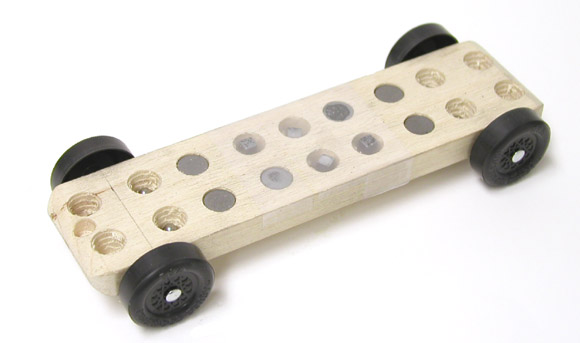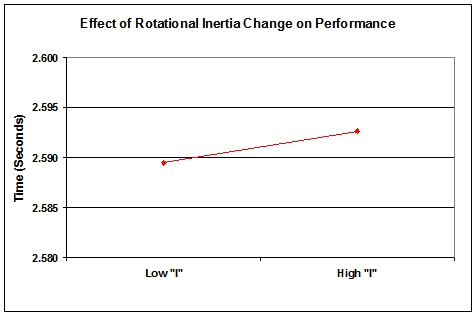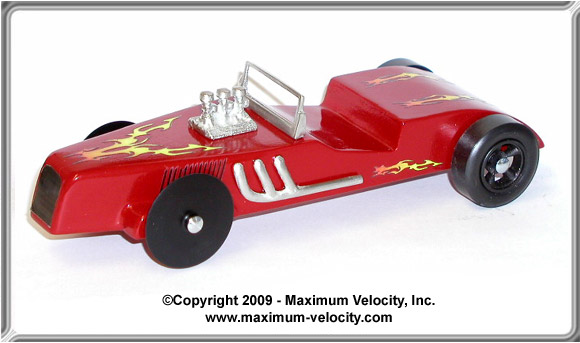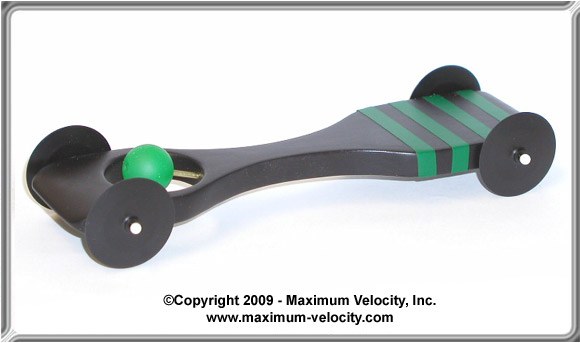– Feature Article – Moment of Inertia Revisited
– Pinewood Derby Car Showcase
– Q&A
Moment of Inertia Revisited
On November 29, 2006 – Pinewood Derby Times Volume 6, Issue 5 an article was published describing the results of an experiment to determine the effect of a change in the moment of inertia on performance. The results of that experiment indicated that a larger moment of inertia was slightly beneficial.
Since then several people have questioned the validity of the results of that test, so the test was reran, making sure that as many variables as possible were eliminated or more tightly controlled. Today’s article documents the results of the new moment of inertia experiment.
What Is Moment Of Inertia?
The moment of inertia is a measure of resistance of an object to rotation. Thus, an object with a small moment of inertia can be more easily rotated than an object with a large moment of inertia. The letter “I” is the normal symbol for the moment of inertia, so it will be used as an abbreviation for the moment of inertia from this point on.
On a pinewood derby car, the size of “I” is determined by the placement of the ballast weight and by the amount of wood and wheel weight. If much of the wood is removed, the ballast weight is focused in one spot, and lighter wheels are used, then “I” will be relatively small. However, if much wood remains, the weight is spread out, and heavier wheels are used, then “I” will be relatively larger.
Real-Life Examples Of “I”
In the original article, the example of a golf putter was provided. Modern putters are weighted to maximize “I”, which leads to more stable putting strokes (refer to the original article for a more detailed explanation).
Another real-life example of the effect of “I” is in figure skating. When a skater wants to spin faster, the arms and legs are pulled in close to the body. This reduces “I” resulting in a more rapid rotation.
Affect Of “I” On Pinewood Derby Cars
“I” affects pinewood derby cars in two ways:
- Left-Right Car Rotation – When a wheel contacts a guide rail, a certain amount of speed is lost. The amount of loss is determined by the force of the impact. If the car has a small “I” (weight concentrated at the balance point), then the impact force is relatively small. But if the car has a large “I” (weight located far from the balance point), then the impact force is greater and the speed loss is relatively greater.
- Up-Down Car Rotation – When a pinewood derby car travels through the curve, it must rotate from the starting angle to a horizontal position. Some energy is required to make this rotation occur, and this energy can only come from the potential energy of the car. Thus, a larger “I” will rob more energy during the transition than a smaller “I”.
Experiment Setup
A special car was used that allowed the weight to be either spread or focused (see Figure 1).
Figure 1 – Test Car
To maximize the change in “I”, center weighting was used. In addition, the following equipment was used:
- 32 Foot Aluminum Freedom Track
- 2.2 Gram Speed Wheels & Speed Axles
- Weight at 5 ounces
- Four wheels on ground
- Alignment adjusted to rail-ride
The wheels were not removed or adjusted during the test. The only change was the positioning of the ballast weight (maximum or minimum “I”). Ten heats were run with each weight position. The high and low results were removed, the remaining times averaged.
Experiment Results
The results are graphed in Figure 2.
Figure 2 – Test Results
As you can see, the low “I” configuration was slightly faster than the high “I” configuration. However, the amount of difference in performance was only three milliseconds, while the standard deviation of the heats was between three and four milliseconds. So, the effect of “I” on performance was extremely small under these experimental conditions.
Note
An interesting (at least to me) side result of the experiment was the consistency of car performance. After measuring the low “I” configuration and the high “I” configuration, the low “I” configuration was retested. Thus, the car ran 30 heats, with a standard deviation of between three and four milliseconds. These results support the value of rail-riding as an alignment technique, and the value of Krytox 100 as a lubricant.
Pinewood Derby Car Showcase
We are out of cars for the showcase, so I am highlighting our cars from 2009. Please submit your cars as detailed below – thanks.
Street Rod – Janel Davis
This car wasn’t particularly competitive, but I wanted to use up an extra PineCar kit that I had lying around. It took fourth place, in the Outlaw behind the extended wheelbase cars with four disk wheels (instead of the two disk wheels on this car).
Green Stealth – Stephen Davis
This car came from my son’s imagination. The green ball is a plastic marble that is just there to “look cool”. The car is painted with flat black paint, and trimmed with 1/4 inch green pin-striping. We used needle axle wheels, allowing the car to easily blow away the competition to take first place. In addition, it took third in design.
(This car, and its twin will be further discussed in an article on needle axle wheels later this season.)
Q&A
My son and I are making “Bullet Bill” from Mario Brothers. I have shaped the body similar to a bullet — circular body that curves to a bull nose in the front. The body is currently the full length of a BSA car. My son wants to cut the vehicle in half length wise. The resulting vehicle would be about three and a half inches in length. My question is what is the draw back of shortening the vehicle?
From my experience the resulting car will be slow compared to the full length vehicles. This is for two reasons:
- Longer cars have the center of gravity further up the hill. These cars will achieve a higher speed upon hitting the flat section due to the greater fall distance.
- Longer cars have a greater distance between the front and back axle. This results in greater stability, and less inclination to zigzag back and forth around the guide rail.
This short of a vehicle would certainly draw attention and be a fun car. But it would almost certainly be a relatively slow car.
We won our pack’s pinewood derby race and now are preparing for the District level race. Our car ran seven heats at the pack race. What troubleshooting should we do and what steps should we take to make sure our car is at peak performance for the District race? Do we need to take off the axles and re-lubricate the wheels? Re-lubricate without taking off the axles? Test for wheel alignment? I don’t want to mess too much with the car, but after seven heats and all the handling at the pack race I’m concerned that the car is possibly not currently at peak condition. Thanks!
Congratulations on the victory. Do you happen to have times for the seven heats? If so, and if they are not slowing down, I would not relube. You can certainly verify the alignment, but if you relube then you will have to make sure to get the lube broken in. When you do this, there is always the risk of damaging the car or slowing it down a little.
If the car had ran many more heats, then I would relube. But at only seven heats, it is probably running at peak performance. It should easily have enough life to complete the district race in good form.
However, it would be good to test the alignment to make sure it is still tracking as desired.
I was wondering if you could tell me approximately how much weight I should allow for my primer, paint job, an a few decals. The car with wheels and axles is now at 4.5 ounces. Should I bring it up to 4.7 or more before the paint? I just don’t have any idea what to allow for paint. I left a small cavity where I can tweak it on race day, but it is small so I need to come fairly close.
If you put on a few coats of spray paint, it generally is about 0.1 ounces (this number would increase with the number of coats). Brush paint generally weighs a little more, as it tends to go on thicker. So if you brought the car up to 4.8, allowed 0.1 for paint, then you can add up to 0.1 at the weigh-in.
Want Answers?
Do you have a pinewood derby-related question? If so, e-mail us your question.We answer all questions by e-mail, but not every question will appear in the Q&A section of the newsletter.
Back Issues
Are you a new subscriber, or have you missed some of the previous newsletters? Don’t miss out; all of the issues for Volume 5 through Volume 17 are posted on our web site.
Newsletter Contributions
We welcome your contributions. If you would like to contribute an article, a web site review, a speed tip, or a pinewood derby memory, please e-mail us.
Subscription Information
The Pinewood Derby Times is a free e-newsletter focused on pinewood derby racing. It is published biweekly from October through March.
If you haven’t already done so, please forward this issue to your pinewood derby friends. But please don’t subscribe your friends. Let them decide for themselves. Thanks.
If this newsletter was forwarded to you, why not subscribe to receive this newsletter. There is no cost, and your e-mail address is safe, as we never sell or share our distribution list.
To subscribe, send a blank e-mail to
[email protected]
You will receive a confirmation e-mail. Reply to the confirmation e-mail and you will start receiving the Pinewood Derby Times with the next issue.
Randy Davis, Editor, Pinewood Derby Times
E-Mail: [email protected]
(C)2018, Maximum Velocity, Inc. All rights reserved. Please do not reprint or place this newsletter on your web site without explicit permission. However, if you like this newsletter we grant permission, and encourage you to e-mail it to a friend.
Maximum Velocity disclaims any personal loss or liability caused by utilization of any information presented in this newsletter.
The Pinewood Derby Times is not specific to, and is not affiliated with the Boy Scouts of America, YMCA, Awana, or any other organization.
(R)Maximum Velocity is a registered trademark of Maximum Velocity, Inc.
(R)Pinewood Derby is a registered trademarks of the Boys Scouts of America.
(R)Awana is a registered trademark of Awana Clubs International.
All other names are trademarks of their respective owners.




